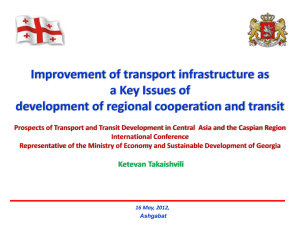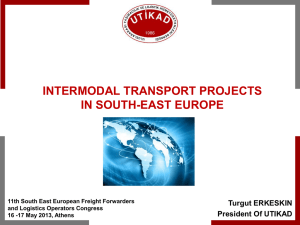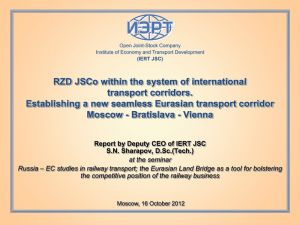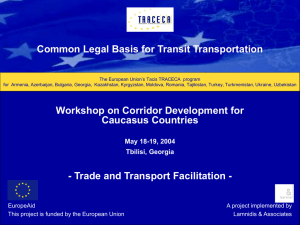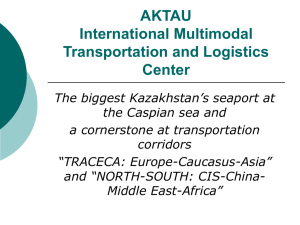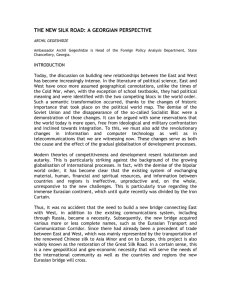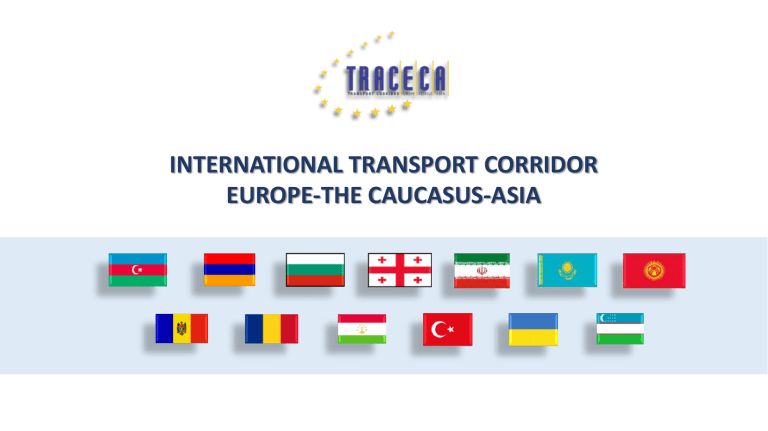
INTERNATIONAL TRANSPORT CORRIDOR EUROPE-THE CAUCASUS-ASIA TRACECA in Brief The TRACECA Programme was initiated by the EU in May 1993 at the Conference in Brussels. The “Basic Multilateral Agreement on International Transport for Development of the Europe-the Caucasus-Asia Corridor” signed on 8 September 1998, Baku, Azerbaijan (MLA) is the legal basis for performance of international traffic along the TRACECA corridor . MLA objectives: development of economic relations, trade and transport communication in the regions of Europe, the Black Sea and the Caspian Sea, the Caucasus and Asia; ensuring international transportation of goods and passengers, as well as international transport of hydrocarbons; ensuring traffic security, cargo safety and environmental protection; ensuring access to the world market of road, air and rail transport, as well as commercial navigation; creation of equal conditions of competition for transport operations INTERGOVERNMENTAL COMMISSION (IGC) TRACECA TRACECA Structure: the highest authority of TRACECA set up for the regulation of the issues regarding the application of the MLA, making decisions for effective functioning of the corridor. The IGC consists of the highest governmental officials of the MLA Parties, the IGC chairmanship rotates every year. PERMANENT SECRETARIAT (PS) IGC TRACECA the executive authority of the IGC, headed by the Secretary General, with the Headquarters in Baku and the Permanent Representations in each of the MLA Parties. 2 Activity of the Permanent Secretariat Tasks of the PS TRACECA: Implementation arrangements: Performing functions of the Information Analytic Centre within the corridor Development of solutions to achieve effective carrying out the MLA Working out recommendations to solve the issues of transportation along the corridor Monitoring of carrying out TRACECA contractual acts Monitoring of the implementation of the IGC and PS decisions Harmonization of legislations of the TRACECA member states Collaboration with the European Commission Collaboration with international organizations in the field of transport Development of recommendations to TRACECA countries Drawing up recommendations to the countries on legislation harmonization in the field of transport and transport operations Elaboration of programme documents and initiatives on the development of the TRACECA corridor Development of drafts of TRACECA agreements, Memorandums of Understanding with international organizations TRACECA Team: • 15 employees of the Headquarters of the PS office • Permanent Representation offices in 13 member states 3 Programme Documents & Agreements STRATEGY of the Intergovernmental Commission TRACECA for development of the international corridor Europe-the Caucasus-Asia for 2016-2026 elaborated on the basis of the TRACECA Master Plan and proposals of the Parties Approved at the XII IGC Meeting, Odessa, 01.06.2016 ACTION PLAN for 2018-2021 for the implementation of the Strategy TRACECA-2026 34 measures Approved at the XIII IGC TRACECA Meeting , Yerevan, 06.03.2018 PLAN OF ACTIONS FOR INCREASE OF COMPETITIVENESS AND ATTRACTIVENESS of TRACECA road routes and further development of international road traffic 20 measures Approved at the XIII IGC TRACECA Meeting , Yerevan, 06.03.2018 Approved at the IX IGC TRACECA Meeting , Bucharest, 24.11.2009 Approved at the XIII IGC TRACECA Meeting , Yerevan, 06.03.2018 Approved at the VII IGC TRACECA Meeting, Issyk Kul, 16.06.2009 TRACECA REGIONAL ACTION STRATEGY ON MARITIME Safety and Security and Environmental Protection for the period up to 2021 (TRAS) 27 measures ROADMAP for development of international transport for the 5-year period 16 measures TRACECA Agreement on Development of Multimodal Transport TRACECA Border Crossing Guide TRACECA Multilateral Permit 4 TRACECA Routes 47 routes 45198 km of international roads and highways 93474 km of railway lines 6960 nautical miles of the routes of ferry and Ro-Ro communications connecting 16 sea ports oil and oil products ore Dynamics of freight transportation along the TRACECA corridor (million tons) 78 80 67 65 74 cereals 72 65 8,8% 40,4% 11% 2013 2014 2015 2016 2017 2018 2019* *Expected volume of traffic along TRACECA for 2019 – 65 million tons (with account taken of amendments to the methods of calculation) construction materials 11% metals and metalware foodstuffs 4,7% 6,5% 5,2% 12,4% chemicals other 5 TRACECA Programme projects: Total implemented projects & Proposed subject matters of new Technical Assistance The EU within the framework of the TRACECA Programme financed 85 projects (14 investment projects, 71 technical assistance projects) to the amount of more than 187 million €. More than 40% of the projects’ budget was allocated for the development of the corridor infrastructure. Projects implementation favoured the attraction of investments to the region . IFI Investments to the TRACECA infrastructure made more than 4 billion Euros. With the view of ensuring harmonized transport development in the TRACECA region it is necessary to implement regional technical assistance projects in the following dimensions: Promotion of creation of customs transit compatible systems, including the institutional, programme and educational aspects Result in reliability. Promotion of the corridor digitalization, including measures on harmonization of TRACECA countries’ legislations regulating the use of electronic documents Result in increasing the quality of traffic through cutting down the costs and reducing the time Support of infrastructure projects of priority routes including the development of logistic centres in TRACECA countries Support of the projects in the field of increasing traffic safety, including maritime security and environmental protection reducing transit time, increasing the level of its Result in connecting of the TEN-T structure with the networks of Central Asia Result in multiplicative effects in the field of climate Digitalization of Markets in the Countries of Central Asia, harmonization of markets, e-trade, e-logistics, digital transport corridors Increase of container traffic volumes in the landlocked TRACECA countries. Optimization mechanism of the transport component of export-import operations for smalland medium-size businesses Feasibility Study of construction of a straightening road along the route Beyneu- Bozoy–Saxaulski (Western Kazakhstan) with the junction to the functioning road М-32 Cargo handling equipment needs assessment for the Caspian Sea ports 6 Containerization of cargo within the TRACECA corridor PRIORITY STEPS OF THE PS TRACECA: EFFECT 1. Certification and competitiveness assessment of the TRACECA routes in comparison with other alternative ITCs Development and adoption of the routes competitiveness assessment technique Carrying out direct certification of the routes Optimization of operation of logistics centres and ports 2. Automatic collection of the data on cargo location and environmental characteristics (for specific goods) Creates prerequisites for the implementation of a single information space of the TRACECA corridor 3. Development of transport component streamlining mechanism for export/import of goods for small and medium enterprises of the landlocked countries Reduction of handling hours of containerized cargo at points of transhipment (about 20 % of economy) 4. Platform for analysis of better traffic rates, including multimodal transport Lowering carrier cost 5. Block chain system for improving the level of reliability and transparency of activities of all actors of the transportation process Advance of performance index of the corridor and country LPI 6. Electronic data processing concerning transport loading /offloading terms along the route 7 Streamlining border-crossing procedures PRIORITY STEPS OF THE PS TRACECA: Development of BCP’s assessment system and determination of the BCP’s list in need of modernization «Hot Line» Implementation of the real time in-transit visibility system Tracking of vehicles’ idle periods Implementation of the best practices “Single window – One stop post” Implementation of electronic preliminary information EFFECT Enhancing the level of traffic transparency Reducing the time of data processing at BCPs Reducing the time of transportation Development of the BCP Assessment System based on the TRACECA Border Crossing Guide Infrastructure - Access infrastructure ASSESSMENT PARAMETERS Occupancy - Related infrastructure - Capacity - Customs/inspection and examination infrastructure - Actual traffic 8 Development of Agreement on Transit Traffic The permit will entitle the motor vehicle authorized within the TRACECA system to perform transit multimodal traffic (involving the Black Sea and Caspian Sea ports) along the whole corridor PRINCIPLE TERMS OF THE AGREEMENT CURRENT STEPS Electronic registration of the motor vehicle in the TRACECA database Conformity of the motor vehicle with the required international standards of environmental compatibility , observance of the requirements of ADR, AETR, etc. Permits will be issued in electronic form supported by mobile application for drivers Advance presentation of traffic information to competent authorities Transfer of the data on the location of the motor vehicle Mutual recognition of the motor vehicle inspections and the results of weighing Available acknowledged electronic locks /customs seals Development of the draft Agreement Discussion of the draft Agreement with the TRACECA states and determination of the Parties positions 9 PROSPECTS ON COOPERATION JOINT STUDY ON THE EFFECTIVENES OF ROUTES COOPERATION IN THE FIELD OF THE HARMONIZATION OF LEGISLATION EXPERIENCE EXCHANGE IN DIGITALIZATION OF TRANSPORT STUDYING BEST PRACTICES IN SIMPLIFICATION OF BORDER CROSSING PROCEDURES 10 PERMANENT SECRETARIAT OF THE INTERGOVERNMENTAL COMMISSION TRACECA Azerbaijan, Baku, T. Aliyarbekov street 8/2, AZ 1005 +994 12 598 27 18 +994 12 498 64 26 office@ps.traceca-org.org www.traceca-org.org USEFUL LINKS IN SOCIAL NETWORK Facebook: IntergovernmentalCommission.TRACECA/ Twitter: @TRACECA LinkedIn: traceca-permanent-secretariat 11
